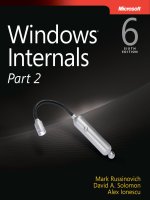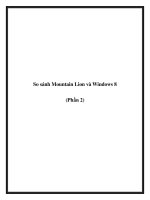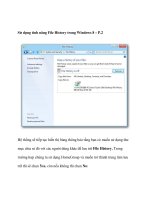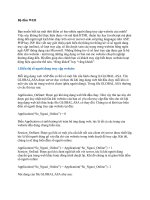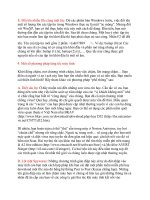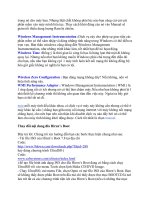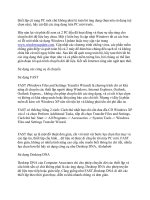Windows® Internals Part 2 potx
Bạn đang xem bản rút gọn của tài liệu. Xem và tải ngay bản đầy đủ của tài liệu tại đây (21.69 MB, 672 trang )
NOTE
Part 2 available Fall 2012
See Table of Contents inside
Part 2
Windows
®
Internals
Russinovich
Solomon
Ionescu
Operating Systems/
Windows
ISBN: 978-0-7356-4873-9
About the Authors
Mark Russinovich is a Technical Fellow in
the Windows Azure
™
group at Microsoft.
He is coauthor of Windows Sysinternals
Administrator’s Reference, co-creator of the
Sysinternals tools available from Microsoft
TechNet, and coauthor of the Windows Internals
book series.
David A. Solomon is coauthor of the
Windows Internals book series and has taught
his Windows internals class to thousands of
developers and IT professionals worldwide,
including Microsoft staff. He is a regular speaker
at Microsoft conferences, including TechNet
and PDC.
Alex Ionescu is a chief software architect and
consultant expert in low-level system software,
kernel development, security training, and
reverse engineering. He teaches Windows
internals courses with David Solomon, and is
active in the security research community.
The denitive guide—fully updated for Windows 7
and Windows Server 2008 R2
Delve inside Windows architecture and internals—and see how core
components work behind the scenes. Led by a team of internationally
renowned internals experts, this classic guide has been fully updated
for Windows 7 and Windows Server® 2008 R2—and now presents its
coverage in two volumes.
As always, you get critical, insider perspectives on how Windows
operates. And through hands-on experiments, you’ll experience its
internal behavior rsthand—knowledge you can apply to improve
application design, debugging, system performance, and support.
In Part 2, you will:
•
Understand how core system and management mechanisms
work—including object manager, synchronization, Wow64,
Hyper-V
®
, and the registry
•
Examine the data structures and activities behind processes,
threads, and jobs
•
Go inside the Windows security model to see how it manages
access, auditing, and authorization
•
Explore the Windows networking stack from top to bottom—
including APIs, BranchCache, protocol and NDIS drivers, and
layered services
•
Dig into internals hands-on using the kernel debugger,
performance monitor, and other tools
Windows
®
Internals
PART 2
microsoft.com/mspress
U.S.A. $39.99
Canada $41.99
[Recommended]
See inside cover
DEVELOPER ROADMAP
Step by Step
• For experienced developers learning a
new topic
• Focus on fundamental techniques and tools
• Hands-on tutorial with practice les plus
eBook
Start Here!
• Beginner-level instruction
• Easy to follow explanations and examples
• Exercises to build your rst projects
Developer Reference
• Professional developers; intermediate to
advanced
• Expertly covers essential topics and
techniques
• Features extensive, adaptable code examples
SIXTH EDITION
6
SIXTH
EDITION
Focused Topics
• For programmers who develop
complex or advanced solutions
• Specialized topics; narrow focus; deep
coverage
• Features extensive, adaptable code examples
Windows
®
Internals
Part 2
6
SIXTH
EDITION
Mark Russinovich
David A. Solomon
Alex Ionescu
spine = 1.2”
Cyan Magenta Yellow Black
PUBLISHED BY
Microsoft Press
A Division of Microsoft Corporation
One Microsoft Way
Redmond, Washington 98052-6399
Copyright © 2012 by David Solomon and Mark Russinovich
All rights reserved. No part of the contents of this book may be reproduced or transmitted in any form or by any
means without the written permission of the publisher.
Library of Congress Control Number: 2012933511
ISBN: 978-0-7356-6587-3
Printed and bound in the United States of America.
First Printing
Microsoft Press books are available through booksellers and distributors worldwide. If you need support related
to this book, email Microsoft Press Book Support at Please tell us what you think of
this book at />Microsoft and the trademarks listed at />Trademarks/EN-US.aspx are trademarks of the Microsoft group of companies. All other marks are property of
their respective owners.
The example companies, organizations, products, domain names, email addresses, logos, people, places, and
events depicted herein are ctitious. No association with any real company, organization, product, domain name,
email address, logo, person, place, or event is intended or should be inferred.
This book expresses the authors’ views and opinions. The information contained in this book is provided without
any express, statutory, or implied warranties. Neither the authors, Microsoft Corporation, nor its resellers, or
distributors will be held liable for any damages caused or alleged to be caused either directly or indirectly by
this book.
Acquisitions Editor: Devon Musgrave
Developmental Editor: Devon Musgrave
Project Editor: Carol Dillingham
Editorial Production: Curtis Philips
Technical Reviewer:
Christophe Nasarre; Technical Review services provided by Content Master,
a member of CM Group, Ltd.
Copyeditor: John Pierce
Indexer: Jan Wright
Cover: Twist Creative
•
Seattle
To our parents, who guided and inspired us to follow our dreams
Contents at a Glance
Windows Internals, Sixth Edition, Part 1 (available separately)
CHAPTER 1 Concepts and Tools
CHAPTER 2 System Architecture
CHAPTER 3 System Mechanisms
CHAPTER 4 Management Mechanisms
CHAPTER 5 Processes, Threads, and Jobs
CHAPTER 6 Security
CHAPTER 7 Networking
Windows Internals, Sixth Edition, Part 2
CHAPTER 8 I/O System 1
CHAPTER 9 Storage Management 125
CHAPTER 10 Memory Management 187
CHAPTER 11 Cache Manager 355
CHAPTER 12 File Systems 391
CHAPTER 13 Startup and Shutdown 499
CHAPTER 14 Crash Dump Analysis 547
vii
Contents
Windows Internals, Sixth Edition, Part 1
(See appendix for Part 1’s table of contents)
Windows Internals, Sixth Edition, Part 2
Introduction xv
Chapter 8 I/O System 1
I/O System Components 1
The I/O Manager 3
Typical I/O Processing 4
Device Drivers 5
Types of Device Drivers 5
Structure of a Driver 12
Driver Objects and Device Objects 14
Opening Devices 19
I/O Processing 25
Types of I/O 25
I/O Request to a Single-Layered Driver 33
I/O Requests to Layered Drivers 40
I/O Cancellation 48
I/O Completion Ports 53
I/O Prioritization 58
Container Notications 65
Driver Verier 65
Kernel-Mode Driver Framework (KMDF) 68
Structure and Operation of a KMDF Driver 68
KMDF Data Model 70
KMDF I/O Model 74
What do you think of this book? We want to hear from you!
Microsoft is interested in hearing your feedback so we can continually improve our
books and learning resources for you. To participate in a brief online survey, please visit:
microsoft.com/learning/booksurvey
viii Contents
User-Mode Driver Framework (UMDF) 78
The Plug and Play (PnP) Manager 81
Level of Plug and Play Support 82
Driver Support for Plug and Play 82
Driver Loading, Initialization, and Installation 84
Driver Installation 94
The Power Manager 98
Power Manager Operation 100
Driver Power Operation 101
Driver and Application Control of Device Power 105
Power Availability Requests 105
Processor Power Management (PPM) 108
Conclusion 123
Chapter 9 Storage Management 125
Storage Terminology 125
Disk Devices 126
Rotating Magnetic Disks 126
Solid State Disks 128
Disk Drivers 131
Winload 132
Disk Class, Port, and Miniport Drivers 132
Disk Device Objects 136
Partition Manager 138
Volume Management 138
Basic Disks 139
Dynamic Disks 141
Multipartition Volume Management 147
The Volume Namespace 153
Volume I/O Operations 159
Virtual Disk Service 160
Virtual Hard Disk Support 162
Attaching VHDs 163
Nested File Systems 163
BitLocker Drive Encryption 163
Encryption Keys 165
Trusted Platform Module (TPM) 168
BitLocker Boot Process 170
BitLocker Key Recovery 172
Contents ix
Full-Volume Encryption Driver 173
BitLocker Management 174
BitLocker To Go 175
Volume Shadow Copy Service
177
Shadow Copies 177
VSS Architecture 177
VSS Operation 178
Uses in Windows 181
Conclusion
186
Chapter 10 Memory Management 187
Introduction to the Memory Manager 187
Memory Manager Components 188
Internal Synchronization 189
Examining Memory Usage 190
Services Provided by the Memory Manager
193
Large and Small Pages 193
Reserving and Committing Pages 195
Commit Limit 199
Locking Memory 199
Allocation Granularity 199
Shared Memory and Mapped Files 200
Protecting Memory 203
No Execute Page Protection 204
Copy-on-Write 209
Address Windowing Extensions 210
Kernel-Mode Heaps (System Memory Pools)
212
Pool Sizes 213
Monitoring Pool Usage 215
Look-Aside Lists 219
Heap Manager
220
Types of Heaps 221
Heap Manager Structure 222
Heap Synchronization 223
The Low Fragmentation Heap 223
Heap Security Features 224
Heap Debugging Features 225
Pageheap 226
Fault Tolerant Heap 227
x Contents
Virtual Address Space Layouts 228
x86 Address Space Layouts 229
x86 System Address Space Layout 232
x86 Session Space 233
System Page Table Entries 235
64-Bit Address Space Layouts 237
x64 Virtual Addressing Limitations 240
Dynamic System Virtual Address Space Management 242
System Virtual Address Space Quotas 245
User Address Space Layout 246
Address Translation 251
x86 Virtual Address Translation 252
Translation Look-Aside Buffer 259
Physical Address Extension (PAE) 260
x64 Virtual Address Translation 265
IA64 Virtual Address Translation 266
Page Fault Handling 267
Invalid PTEs 268
Prototype PTEs 269
In-Paging I/O 271
Collided Page Faults 272
Clustered Page Faults 272
Page Files 273
Commit Charge and the System Commit Limit 275
Commit Charge and Page File Size 278
Stacks 279
User Stacks 280
Kernel Stacks 281
DPC Stack 282
Virtual Address Descriptors 282
Process VADs 283
Rotate VADs 284
NUMA 285
Section Objects 286
Driver Verier 292
Page Frame Number Database 297
Page List Dynamics 300
Page Priority 310
Modied Page Writer 314
Contents xi
PFN Data Structures 315
Physical Memory Limits 320
Windows Client Memory Limits 321
Working Sets 324
Demand Paging 324
Logical Prefetcher 324
Placement Policy 328
Working Set Management 329
Balance Set Manager and Swapper 333
System Working Sets 334
Memory Notication Events 335
Proactive Memory Management (Superfetch) 338
Components 338
Tracing and Logging 341
Scenarios 342
Page Priority and Rebalancing 342
Robust Performance 344
ReadyBoost 346
ReadyDrive 348
Unied Caching 348
Process Reection 351
Conclusion 354
Chapter 11 Cache Manager 355
Key Features of the Cache Manager 355
Single, Centralized System Cache 356
The Memory Manager 356
Cache Coherency 356
Virtual Block Caching 358
Stream-Based Caching 358
Recoverable File System Support 359
Cache Virtual Memory Management 360
Cache Size. . . . . . . . . . . . . . . . . . . . . . . . . . . . . . . . . . . . . . . . . . . . . . . . . . . . . .361
Cache Virtual Size 361
Cache Working Set Size 361
Cache Physical Size 363
Cache Data Structures 364
Systemwide Cache Data Structures 365
Per-File Cache Data Structures 368
xii Contents
File System Interfaces 373
Copying to and from the Cache 374
Caching with the Mapping and Pinning Interfaces 374
Caching with the Direct Memory Access Interfaces 375
Fast I/O 375
Read-Ahead and Write-Behind 377
Intelligent Read-Ahead 378
Write-Back Caching and Lazy Writing 379
Write Throttling 388
System Threads 390
Conclusion 390
Chapter 12 File Systems 391
Windows File System Formats 392
CDFS 392
UDF 393
FAT12, FAT16, and FAT32 393
exFAT 396
NTFS 397
File System Driver Architecture 398
Local FSDs 398
Remote FSDs 400
File System Operation 407
File System Filter Drivers 413
Troubleshooting File System Problems 415
Process Monitor Basic vs. Advanced Modes 415
Process Monitor Troubleshooting Techniques 416
Common Log File System 416
NTFS Design Goals and Features 424
High-End File System Requirements 424
Advanced Features of NTFS 426
NTFS File System Driver 439
NTFS On-Disk Structure 442
Volumes 442
Clusters 442
Master File Table 443
File Record Numbers 447
File Records 447
File Names 449
Contents xiii
Resident and Nonresident Attributes 453
Data Compression and Sparse Files 456
The Change Journal File 461
Indexing 464
Object IDs 466
Quota Tracking 466
Consolidated Security 467
Reparse Points 469
Transaction Support 469
NTFS Recovery Support 477
Design 478
Metadata Logging 479
Recovery 483
NTFS Bad-Cluster Recovery 487
Self-Healing 490
Encrypting File System Security 491
Encrypting a File for the First Time 494
The Decryption Process 496
Backing Up Encrypted Files 497
Copying Encrypted Files 497
Conclusion 498
Chapter 13 Startup and Shutdown 499
Boot Process 499
BIOS Preboot. . . . . . . . . . . . . . . . . . . . . . . . . . . . . . . . . . . . . . . . . . . . . .499
The BIOS Boot Sector and Bootmgr 502
The UEFI Boot Process 512
Booting from iSCSI 514
Initializing the Kernel and Executive Subsystems 514
Smss, Csrss, and Wininit 522
ReadyBoot 527
Images That Start Automatically 528
Troubleshooting Boot and Startup Problems 529
Last Known Good 530
Safe Mode 530
Windows Recovery Environment (WinRE) 534
Solving Common Boot Problems 537
Shutdown 542
Conclusion 545
xiv Contents
Chapter 14 Crash Dump Analysis 547
Why Does Windows Crash? 547
The Blue Screen 548
Causes of Windows Crashes 549
Troubleshooting Crashes 551
Crash Dump Files. . . . . . . . . . . . . . . . . . . . . . . . . . . . . . . . . . . . . . . . . . . . . . . .553
Crash Dump Generation 559
Windows Error Reporting 561
Online Crash Analysis 563
Basic Crash Dump Analysis 564
Notmyfault 564
Basic Crash Dump Analysis 565
Verbose Analysis 567
Using Crash Troubleshooting Tools 569
Buffer Overruns, Memory Corruption, and Special Pool 569
Code Overwrite and System Code Write Protection 573
Advanced Crash Dump Analysis 574
Stack Trashes 575
Hung or Unresponsive Systems 577
When There Is No Crash Dump 581
Analysis of Common Stop Codes 585
0xD1 - DRIVER_IRQL_NOT_LESS_OR_EQUAL 585
0x8E - KERNEL_MODE_EXCEPTION_NOT_HANDLED 586
0x7F - UNEXPECTED_KERNEL_MODE_TRAP 588
0xC5 - DRIVER_CORRUPTED_EXPOOL 590
Hardware Malfunctions 593
Conclusion 594
Appendix: Contents of Windows Internals, Sixth Edition, Part 1 595
Index 603
What do you think of this book? We want to hear from you!
Microsoft is interested in hearing your feedback so we can continually improve our
books and learning resources for you. To participate in a brief online survey, please visit:
microsoft.com/learning/booksurvey
xv
Introduction
W
indows Internals, Sixth Edition is intended for advanced computer professionals
(both developers and system administrators) who want to understand how the
core components of the Microsoft Windows 7 and Windows Server 2008 R2 operating
systems work internally. With this knowledge, developers can better comprehend the
rationale behind design choices when building applications specic to the Windows
platform. Such knowledge can also help developers debug complex problems. System
administrators can benet from this information as well, because understanding how
the operating system works “under the covers” facilitates understanding the perfor-
mance behavior of the system and makes troubleshooting system problems much
easier when things go wrong. After reading this book, you should have a better under-
standing of how Windows works and why it behaves as it does.
Structure of the Book
For the rst time, the book has been divided in two parts. This was done to get the
information out more quickly since it takes considerable time to update the book for
each release of Windows.
Part 1 begins with two chapters that dene key concepts, introduce the tools used in
the book, and describe the overall system architecture and components. The next two
chapters present key underlying system and management mechanisms. Part 1 wraps
up by covering three core components of the operating system: processes, threads, and
jobs; security; and networking.
Part 2 covers the remaining core subsystems: I/O, storage, memory management,
the cache manager, and le systems. Part 2 concludes with a description of the startup
and shutdown processes and a description of crash-dump analysis.
xvi Introduction
History of the Book
This is the sixth edition of a book that was originally called Inside Windows NT
(Microsoft Press, 1992), written by Helen Custer (prior to the initial release of Microsoft
Windows NT 3.1). Inside Windows NT was the rst book ever published about Windows
NT and provided key insights into the architecture and design of the system. Inside
Windows NT, Second Edition (Microsoft Press, 1998) was written by David Solomon. It
updated the original book to cover Windows NT 4.0 and had a greatly increased level
of technical depth.
Inside Windows 2000, Third Edition (Microsoft Press, 2000) was authored by David
Solomon and Mark Russinovich. It added many new topics, such as startup and shut-
down, service internals, registry internals, le-system drivers, and networking. It also
covered kernel changes in Windows 2000, such as the Windows Driver Model (WDM),
Plug and Play, power management, Windows Management Instrumentation (WMI),
encryption, the job object, and Terminal Services. Windows Internals, Fourth Edition was
the Windows XP and Windows Server 2003 update and added more content focused
on helping IT professionals make use of their knowledge of Windows internals, such as
using key tools from Windows Sysinternals (www.microsoft.com/technet/sysinternals)
and analyzing crash dumps. Windows Internals, Fifth Edition was the update for
Windows Vista and Windows Server 2008. New content included the image loader,
user-mode debugging facility, and Hyper-V.
Sixth Edition Changes
This latest edition has been updated to cover the kernel changes made in Windows 7
and Windows Server 2008 R2. Hands-on experiments have been updated to reect
changes in tools.
Hands-on Experiments
Even without access to the Windows source code, you can glean much about Windows
internals from tools such as the kernel debugger and tools from Sysinternals and
Winsider Seminars & Solutions. When a tool can be used to expose or demonstrate
some aspect of the internal behavior of Windows, the steps for trying the tool yourself
are listed in “EXPERIMENT” boxes. These appear throughout the book, and we encour-
age you to try these as you’re reading—seeing visible proof of how Windows works
internally will make much more of an impression on you than just reading about it will.
Introduction xvii
Topics Not Covered
Windows is a large and complex operating system. This book doesn’t cover everything
relevant to Windows internals but instead focuses on the base system components. For
example, this book doesn’t describe COM+, the Windows distributed object-oriented
programming infrastructure, or the Microsoft .NET Framework, the foundation of man-
aged code applications.
Because this is an internals book and not a user, programming, or system administra-
tion book, it doesn’t describe how to use, program, or congure Windows.
A Warning and a Caveat
Because this book describes undocumented behavior of the internal architecture and
the operation of the Windows operating system (such as internal kernel structures and
functions), this content is subject to change between releases. (External interfaces, such
as the Windows API, are not subject to incompatible changes.)
By “subject to change,” we don’t necessarily mean that details described in this book
will change between releases, but you can’t count on them not changing. Any soft-
ware that uses these undocumented interfaces might not work on future releases of
Windows. Even worse, software that runs in kernel mode (such as device drivers) and
uses these undocumented interfaces might experience a system crash when running on
a newer release of Windows.
Acknowledgments
First, thanks to Jamie Hanrahan and Brian Catlin of Azius, LLC for joining us on this
project—the book would not have been nished without their help. They did the bulk
of the updates on the “Security” and “Networking” chapters and contributed to the
update of the “Management Mechanisms” and “Processes and Threads” chapters. Azius
provides Windows-internals and device-driver training. See www.azius.com for more
information.
We want to recognize Alex Ionescu, who for this edition is a full coauthor. This is a
reection of Alex’s extensive work on the fth edition, as well as his continuing work on
this edition.
xviii Introduction
Also thanks to Daniel Pearson, who updated the “Crash Dump Analysis” chapter.
His many years of dump analysis experience helped to make the information more
practical.
Thanks to Eric Traut and Jon DeVaan for continuing to allow David Solomon access
to the Windows source code for his work on this book as well as continued develop-
ment of his Windows Internals courses.
Three key reviewers were not acknowledged for their review and contributions
to the fth edition: Arun Kishan, Landy Wang, and Aaron Margosis—thanks again to
them! And thanks again to Arun and Landy for their detailed review and helpful input
for this edition.
This book wouldn’t contain the depth of technical detail or the level of accuracy it
has without the review, input, and support of key members of the Microsoft Windows
development team. Therefore, we want to thank the following people, who provided
technical review and input to the book:
■
Greg Cottingham
■
Joe Hamburg
■
Jeff Lambert
■
Pavel Lebedinsky
■
Joseph East
■
Adi Oltean
■
Alexey Pakhunov
■
Valerie See
■
Brad Waters
■
Bruce Worthington
■
Robin Alexander
■
Bernard Ourghanlian
Also thanks to Scott Lee, Tim Shoultz, and Eric Kratzer for their assistance with the
“Crash Dump Analysis” chapter.
For the “Networking” chapter, a special thanks to Gianluigi Nusca and Tom Jolly,
who really went beyond the call of duty: Gianluigi for his extraordinary help with
the BranchCache material and the amount of suggestions (and many paragraphs of
Introduction xix
material he wrote), and Tom Jolly not only for his own review and suggestions (which
were excellent), but for getting many other developers to assist with the review. Here
are all those who reviewed and contributed to the “Networking” chapter:
■
Roopesh Battepati
■
Molly Brown
■
Greg Cottingham
■
Dotan Elharrar
■
Eric Hanson
■
Tom Jolly
■
Manoj Kadam
■
Greg Kramer
■
David Kruse
■
Jeff Lambert
■
Darene Lewis
■
Dan Lovinger
■
Gianluigi Nusca
■
Amos Ortal
■
Ivan Pashov
■
Ganesh Prasad
■
Paul Swan
■
Shiva Kumar Thangapandi
Amos Ortal and Dotan Elharrar were extremely helpful on NAP, and Shiva Kumar
Thangapandi helped extensively with EAP.
Thanks to Gerard Murphy for reviewing the shutdown mechanisms in Windows 7
and clarifying Group Policy behaviors.
Thanks to Tristan Brown from the Power Management team at Microsoft for spend-
ing a few late hours at the ofce with Alex going over core parking’s algorithms and
behaviors, as well as for the invaluable diagram he provided.
xx Introduction
Thanks to Apurva Doshi for sending Alex a detailed document of cache manager
changes in Windows 7, which was used to capture some of the new behaviors and
changes described in the book.
Thanks to Matthieu Suiche for his kernel symbol le database, which allowed Alex to
discover new and removed elds from core kernel data structures and led to the inves-
tigations to discover the underlying functionality changes.
Thanks to Cenk Ergan, Michel Fortin, and Mehmet Iyigun for their review and input
on the Superfetch details.
The detailed checking Christophe Nasarre, overall technical reviewer, performed
contributed greatly to the technical accuracy and consistency in the book.
We would like to again thank Ilfak Guilfanov of Hex-Rays (www.hex-rays.com) for the
IDA Pro Advanced and Hex-Rays licenses they granted to Alex so that he could speed
up his reverse engineering of the Windows kernel.
Finally, the authors would like to thank the great staff at Microsoft Press behind
turning this book into a reality. Devon Musgrave served double duty as acquisitions
editor and developmental editor, while Carol Dillingham oversaw the title as its project
editor. Editorial and production manager Curtis Philips, copy editor John Pierce, proof-
reader Andrea Fox, and indexer Jan Wright also contributed to the quality of this book.
Last but not least, thanks to Ben Ryan, publisher of Microsoft Press, who continues
to believe in the importance of continuing to provide this level of detail about Windows
to their readers!
Errata & Book Support
We’ve made every effort to ensure the accuracy of this book and its companion con-
tent. Any errors that have been reported since this book was published are listed on our
Microsoft Press site at oreilly.com:
/>If you nd an error that is not already listed, you can report it to us through the
same page.
If you need additional support, email Microsoft Press Book Support at mspinput@
microsoft.com.
Introduction xxi
Please note that product support for Microsoft software is not offered through the
addresses above.
We Want to Hear from You
At Microsoft Press, your satisfaction is our top priority, and your feedback our most
valuable asset. Please tell us what you think of this book at:
/>The survey is short, and we read every one of your comments and ideas. Thanks in
advance for your input!
Stay in Touch
Let’s keep the conversation going! We’re on Twitter: />
1
CHAPTER 8
I/O System
T
he Windows I/O system consists of several executive components that together manage hard-
ware devices and provide interfaces to hardware devices for applications and the system. In this
chapter, we’ll rst list the design goals of the I/O system, which have inuenced its implementation.
We’ll then cover the components that make up the I/O system, including the I/O manager, Plug and
Play (PnP) manager, and power manager. Then we’ll examine the structure and components of the
I/O system and the various types of device drivers. We’ll look at the key data structures that describe
devices, device drivers, and I/O requests, after which we’ll describe the steps necessary to complete
I/O requests as they move through the system. Finally, we’ll present the way device detection, driver
installation, and power management work.
I/O System Components
The design goals for the Windows I/O system are to provide an abstraction of devices, both hardware
(physical) and software (virtual or logical), to applications with the following features:
■
Uniform security and naming across devices to protect shareable resources. (See Chapter 6,
“Security,” in Part 1 for a description of the Windows security model.)
■
High-performance asynchronous packet-based I/O to allow for the implementation of scalable
applications.
■
Services that allow drivers to be written in a high-level language and easily ported between
different machine architectures.
■
Layering and extensibility to allow for the addition of drivers that transparently modify the be-
havior of other drivers or devices, without requiring any changes to the driver whose behavior
or device is modied.
■
Dynamic loading and unloading of device drivers so that drivers can be loaded on demand
and not consume system resources when unneeded.
■
Support for Plug and Play, where the system locates and installs drivers for newly detected
hardware, assigns them hardware resources they require, and also allows applications to dis-
cover and activate device interfaces.
2 Windows Internals, Sixth Edition, Part 2
■
Support for power management so that the system or individual devices can enter low power
states.
■
Support for multiple installable le systems, including FAT, the CD-ROM le system (CDFS), the
Universal Disk Format (UDF) le system, and the Windows le system (NTFS). (See Chapter 12,
“File Systems,” for more specic information on le system types and architecture.)
■
Windows Management Instrumentation (WMI) support and diagnosability so that drivers can
be managed and monitored through WMI applications and scripts. (WMI is described in Chap-
ter 4, “Management Mechanisms,” in Part 1.)
To implement these features the Windows I/O system consists of several executive components as
well as device drivers, which are shown in Figure 8-1.
■
The I/O manager is the heart of the I/O system. It connects applications and system compo-
nents to virtual, logical, and physical devices, and it denes the infrastructure that supports
device drivers.
■
A device driver typically provides an I/O interface for a particular type of device. A driver is a
software module that interprets high-level commands, such as read or write, and issues low-
level, device-specic commands, such as writing to control registers. Device drivers receive
commands routed to them by the I/O manager that are directed at the devices they manage,
and they inform the I/O manager when those commands are complete. Device drivers often
use the I/O manager to forward I/O commands to other device drivers that share in the imple-
mentation of a device’s interface or control.
■
The PnP manager works closely with the I/O manager and a type of device driver called a bus
driver to guide the allocation of hardware resources as well as to detect and respond to the
arrival and removal of hardware devices. The PnP manager and bus drivers are responsible for
loading a device’s driver when the device is detected. When a device is added to a system that
doesn’t have an appropriate device driver, the executive Plug and Play component calls on the
device installation services of a user-mode PnP manager.
■
The power manager also works closely with the I/O manager and the PnP manager to guide
the system, as well as individual device drivers, through power-state transitions.
■
Windows Management Instrumentation support routines, called the Windows Driver Model
(WDM) WMI provider, allow device drivers to indirectly act as providers, using the WDM WMI
provider as an intermediary to communicate with the WMI service in user mode. (For more
information on WMI, see the section “Windows Management Instrumentation” in Chapter 4 in
Part 1.)
■
The registry serves as a database that stores a description of basic hardware devices attached
to the system as well as driver initialization and conguration settings. (See “The Registry” sec-
tion in Chapter 4 in Part 1 for more information.)
■
INF les, which are designated by the .inf extension, are driver installation les. INF les are
the link between a particular hardware device and the driver that assumes primary control of
CHAPTER 8 I/O System 3
the device. They are made up of script-like instructions describing the device they correspond
to, the source and target locations of driver les, required driver-installation registry modica-
tions, and driver dependency information. Digital signatures that Windows uses to verify that
a driver le has passed testing by the Microsoft Windows Hardware Quality Labs (WHQL) are
stored in .cat les. Digital signatures are also used to prevent tampering of the driver or its
INF le.
■
The hardware abstraction layer (HAL) insulates drivers from the specics of the processor and
interrupt controller by providing APIs that hide differences between platforms. In essence, the
HAL is the bus driver for all the devices soldered onto the computer’s motherboard that aren’t
controlled by other drivers.
Windows
services
Applications
WMI
service
User-mode
PnP manager
User mode
Kernel mode
.inf files,
.cat files,
registry
I/O
manager
Power
manager
PnP
manager
WDM WMI
routines
I/O system
Drivers
HAL
Setup com-
ponents library
(Setupapi.dll)
FIGURE 8-1 I/O system components
The I/O Manager
The I/O manager is the core of the I/O system because it denes the orderly framework, or model,
within which I/O requests are delivered to device drivers. The I/O system is packet driven. Most I/O re-
quests are represented by an I/O request packet (IRP), which travels from one I/O system component
to another. (As you’ll discover in the section “Fast I/O,” fast I/O is the exception; it doesn’t use IRPs.)

